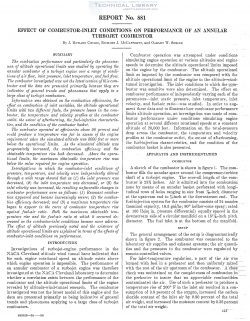naca-report-881

- Version
- 175 Downloads
- 2.20 MB File Size
- 1 File Count
- August 31, 2016 Create Date
- August 31, 2016 Last Updated
National Advisory Committee for Aeronautics, Report - Effect of Combustor Inlet Conditions on Performance of an Annular Turbojet Combustor

The combustion performance and particularly the phenome-
non of altitude operational limits was studied by operating the
annular comb-ustor of a turbo-jet engine orer a range of condi—
tions of airflow, inlet pressure, inlet temperature, andfuelflow.
The combustor inrestigated was not the latest rersion of this com-
bustor and the data are presented primarily because they are
indicat-iee of general trends and phenomena that apply to a
large class of turbojet combustors.
Information was obtained on the combustion efiiciencies, the
efiect on combustion of inlet eariables, the altitude operational
limits with turn different fuels, the pressure losses in the corn-
bustor, the temperature and z'elocity profiles at the combustor
outlet. the extent of afterburning, the fuel-injection characteris—
tics. and the condition of the combustor basket.
The, combustor operated at aficiencies abore 90 percent and
could produce a temperature rise far in excess of the engine
requirement when the simulated altitude was 8000 feet or more
below the operational limits. As the simulated altitude icas
progressirely increased, the combustion eficiencp and the
obtainable temperature rise both decreased. Above the opera-
tional limits, the maximum obtainable temperature rise was
below the ralue required for engine operation.
Incestigations in which the combustor—inlet conditions of
pressure, temperature, and relocity were independently altered
through a wide range showed that as {1 ) the inlet pressure was
decreased. (:2) the inlet temperature was decreased, or (S) the
inlet i'elocity was increased, the resulting unfarorable changes in
combustor performance were as follows: (I) Resonant comb-us-
tion appeared and became increasingly serere; (2) the combus-
tion efficiency decreased; and (3} a maximum temperature rise
began to appear in the curse of combustor temperature rise
against fuel—air ratio. Both the maximum obtainable tem-
perature rise and the fuel—air ratio at which it occurred de—
creased as the combustor-inlet conditions became more adrerse.
The eject of altitude preriously noted and the existence of
altitude operational limits are explained in terms of the ejects of
combustor-inlet conditions on performance.
| File | Action |
|---|---|
| naca-report-881 Effect of Combustor Inlet Conditions on Performance of an Annular Turbojet Combustor.pdf | Download |

Comment On This Post